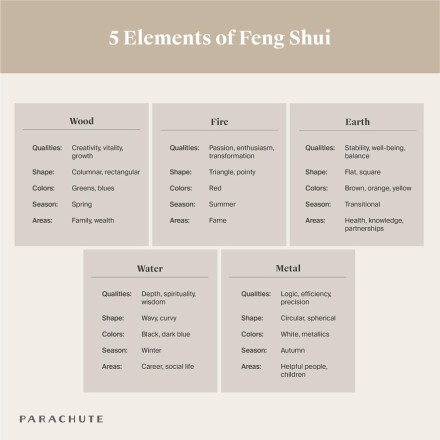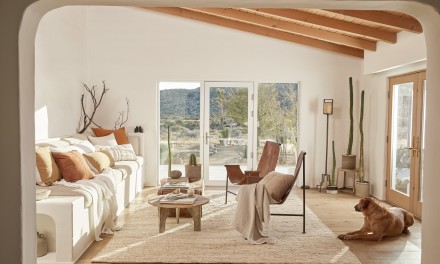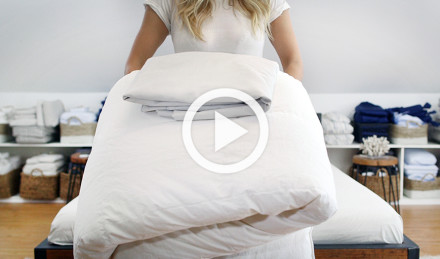Feng Shui brings balance and serenity to our lives by promoting positive energy flow throughout our homes. This ancient Chinese philosophy is based on the idea of optimizing “Chi” with the help of the five elements: earth, water, fire, wood and metal.
While that description may sound a bit abstract and mystical, Feng Shui’s interior design principles are actually easy to implement in practice. The reward is a healthier, uncluttered and more harmonious home aesthetic.
The allure of Feng shui design is its simplicity, which puts us in a better mood and state of mind. Here, we explore the most common Feng Shui rules, the Bagua map and share useful tips on applying them in each room of your house.
What Is Feng Shui?
Feng Shui is the art of placing and arranging objects to facilitate the free flow of Chi — the force that permeates all aspects of life. Feng Shui originated in China more than 3,000 years ago. The literal translation of the phrase is “wind (Feng) and water” (Shui).
Both elements are associated with good health in Chinese culture. In this context, wind and water evoke the infinite and unrestricted movement of Chi.
Feng Shui interior decorating aims to enhance different aspects of your life, by putting you in sync with the environment you live in as energy enters your home. To achieve this, Feng Shui rules work with the five elements and a pattern called the Bagua map. These tools guide the placement of furniture and decor items in your home.
Would you like it if there were no more daylight savings time? You may get your wish soon. See our article: Daylight Savings Ending: Will It End for Good?
What Is Feng Shui?
Feng Shui is the art of placing and arranging objects to facilitate the free flow of Chi — the force that permeates all aspects of life. Feng Shui originated in China more than 3,000 years ago. The literal translation of the phrase is “wind (Feng) and water” (Shui).
Both elements are associated with good health in Chinese culture. In this context, wind and water evoke the infinite and unrestricted movement of Chi.
Feng Shui interior decorating aims to enhance different aspects of your life, by putting you in sync with the environment you live in as energy enters your home. To achieve this, Feng Shui rules work with the five elements and a pattern called the Bagua map. These tools guide the placement of furniture and decor items in your home.
Would you like it if there were no more daylight savings time? You may get your wish soon. See our article: Daylight Savings Ending: Will It End for Good?
What Are the Five Feng Shui Elements?
At the core of Feng Shui decorating is the balance of the five elements: wind, water, fire, wood and metal. Each one symbolizes certain qualities such as stability, wisdom, growth and creativity. So — to live your most fulfilling life, your home must balance all five elements in its decor.
What Are the Five Feng Shui Elements?
At the core of Feng Shui decorating is the balance of the five elements: wind, water, fire, wood and metal. Each one symbolizes certain qualities such as stability, wisdom, growth and creativity. So — to live your most fulfilling life, your home must balance all five elements in its decor.

Wood
This element symbolizes creativity, growth and vitality. When decorating with it, opt for shapes that imitate trees, tree trunks, leaves and flowers. Wood’s colors are green and blue.
Wood
This element symbolizes creativity, growth and vitality. When decorating with it, opt for shapes that imitate trees, tree trunks, leaves and flowers. Wood’s colors are green and blue.
Fire
Fire governs passion, transformation, energy and enthusiasm. Incorporate candles and different types of lighting, as well as decor pieces in red, pink and purple.
Fire
Fire governs passion, transformation, energy and enthusiasm. Incorporate candles and different types of lighting, as well as decor pieces in red, pink and purple.
Metal
This is the element of logic, efficiency and precision. Metal items in spherical and round shapes will enhance the material’s productive presence in your home.
Metal
This is the element of logic, efficiency and precision. Metal items in spherical and round shapes will enhance the material’s productive presence in your home.
Water
Water symbolizes spirituality and wisdom. Add mirrors, aquariums or fountains in irregular shapes to foster relaxation.
Water
Water symbolizes spirituality and wisdom. Add mirrors, aquariums or fountains in irregular shapes to foster relaxation.
Earth
The Earth element controls stability, physical strength and balance. To bring this rejuvenating element inside, decorate rooms in earthy tones and incorporate images of landscapes.
Earth
The Earth element controls stability, physical strength and balance. To bring this rejuvenating element inside, decorate rooms in earthy tones and incorporate images of landscapes.
How Does the Bagua Map Work in Feng Shui Interior Design?
The primary tool used in Feng Shui design is the Bagua map. “Bagua” means “eight areas” in Chinese. It’s essentially a Feng Shui room map divided into eight sections. Each one relates to a different aspect of your life, such as family, career, fame, wealth, knowledge, love, children and helpful people/travel. A ninth section in the center is for you. All nine areas link to a specific element and color, guiding your Feng Shui interior design decisions.
The easiest way to use a Bagua map is to overlay it on the floorplan of your apartment or house. Put the front door at the bottom of the page.
How Does the Bagua Map Work in Feng Shui Interior Design?
The primary tool used in Feng Shui design is the Bagua map. “Bagua” means “eight areas” in Chinese. It’s essentially a Feng Shui room map divided into eight sections. Each one relates to a different aspect of your life, such as family, career, fame, wealth, knowledge, love, children and helpful people/travel. A ninth section in the center is for you. All nine areas link to a specific element and color, guiding your Feng Shui interior design decisions.
The easiest way to use a Bagua map is to overlay it on the floorplan of your apartment or house. Put the front door at the bottom of the page.

How to Use the Bagua Map
It’s not hard to use a Bagua map to beautify your home. Let’s take a look at how it works, along with a few Feng Shui examples to get you started.
In the Bagua map, the wealth quadrant is associated with wood and blue. Fire rules the fame area, where you should add items in red, and tall objects such as floor lamps. Next up are love and romantic partnerships. Add candles and always pair decorative objects in twos. The fourth quadrant is family,associated with wood. Green is the dominant color here.
Earth and yellow rule the health area. Purple and metal are the leading Feng Shui decor elements in the children quadrant. Wisdom is also ruled by Earth. Decorate spaces that fall within this quadrant with books and plenty of greenery. Your career is in the eighth area. Place mirrors and other reflective surfaces here, and opt for decorative objects in dark grey and black. And finally, the quadrant of travel and helping people is ruled by metal and white.
How to Use the Bagua Map
It’s not hard to use a Bagua map to beautify your home. Let’s take a look at how it works, along with a few Feng Shui examples to get you started.
In the Bagua map, the wealth quadrant is associated with wood and blue. Fire rules the fame area, where you should add items in red, and tall objects such as floor lamps. Next up are love and romantic partnerships. Add candles and always pair decorative objects in twos. The fourth quadrant is family,associated with wood. Green is the dominant color here.
Earth and yellow rule the health area. Purple and metal are the leading Feng Shui decor elements in the children quadrant. Wisdom is also ruled by Earth. Decorate spaces that fall within this quadrant with books and plenty of greenery. Your career is in the eighth area. Place mirrors and other reflective surfaces here, and opt for decorative objects in dark grey and black. And finally, the quadrant of travel and helping people is ruled by metal and white.
Feng Shui Home Decorating Tips and Examples by Room
Now that you’ve mastered the two main Feng Shui design elements, let’s dive into decorating each room.
Feng Shui Home Decorating Tips and Examples by Room
Now that you’ve mastered the two main Feng Shui design elements, let’s dive into decorating each room.
Living Room Feng Shui Tips
Living Room Feng Shui Tips
Declutter and air out your living room to allow Feng Shui energy to flow freely through it. Add plenty of plants to bring the outdoors in. Make sure your furniture is comfortable, inviting and predisposing relaxation. The position of your seating furniture should encourage communication.
Ideally, your sofa should face the door, and should be placed against a wall. This is the “commanding position” in the room, creating a clear view of the door. Use the Bagua map to decide on the best shape for a coffee table, and to choose the dominant color in the room. To select the dominant color, lay the map over the floorplan of your home and see which quadrant your living room falls into. For instance, if it falls into the family area, decorate with family heirlooms and opt for furniture in rectangular shapes.
Place see-through washed linen curtains on the windows and avoid black-out shades. This technique lets light in without letting positive energy escape.
If you have a fireplace in the living room, don’t mount your TV above it, making it the focal point. Don’t over-accessorize your shelves, either. Display only items that are meaningful to you. Remember, clutter is a huge faux-pas in Feng Shui interior design.
Kitchen Feng Shui Tips
Kitchen Feng Shui Tips
Feng Shui house layout principles dictate that the kitchen should be at the back of the home — either at the south or north end of the house. But if yours doesn’t fit this mold, don’t worry. You can still bring positive energy to your cooking area.
Per Feng Shui rules, the kitchen is one of the most important rooms for your health, and the stove is at its heart. If possible, avoid placing your sink next to the stove. This creates a clash between the two elements of fire and water.
If your cabinets don’t reach all the way to the ceiling, fill the space between them with plants or kitchen decor. Do this to prevent the accumulation of negative energy and dust.
Add plenty of metal and wood accents in your kitchen, too. This promotes productivity and strengthens family bonds. Make sure your stove is working correctly, and fix or discard broken items or appliances. Finally, use the Bagua map to find the best color for your kitchen. You can use it on your walls, your cabinets, wall hangings, objets d’art, or in a custom backsplash. For an easier introduction to kitchen Feng Shui basics, style surfaces in table linens in your chosen shade.
Home Office Feng Shui Tips
Home Office Feng Shui Tips
Less is more is one of the leading Feng Shui design rules. In the home office, this starts with decluttering and organizing your desk. Leave only pieces of furniture and items that contribute to your productivity — or help you visualize professional goals.
The best position for your desk is facing the door and with a solid wall behind you. Taking time to consider the commanding position for your desk is important because it defines how you “face” future business opportunities.
Because Feng Shui principles encourage harmony with the environment, choose a wooden desk that brings a natural aesthetic to your work space. Avoid clashing colors and instead, choose shades that nourish your natural creativity. Shades of yellow, green and blue are best. These hues help relax your mind, so you can focus on your projects. If you’d like to add a pop of color, go for a few red accents.
Bedroom Feng Shui Tips
Bedroom Feng Shui Tips
In designing your bedroom, start by finding the commanding position for your bed — the largest piece of furniture in the room. According to Feng Shui interior design rules, it should rest against a wall and opposite the door. If it doesn’t have a headboard, buy one. Headboards create a feeling of protection and support. Choose a design with soft edges — an upholstered headboard is best. Avoid those made from metal such as wrought iron. In general, avoid furniture with sharp corners, preferring decor that promotes tranquility and rest.
Consider sheets in soothing, earthy shades like beige, grey, terracotta or off-white. Opt for bedding made from natural fibers such as long-staple cotton or linen. If you’d like to read more about these and other sleep promoting materials, see our Fabric & Bedding Materials Guide.
Layer your bed with a cozy down duvet or a quilt to make it as inviting as possible while fostering a positive energy flow. Finally, always style items such as pillows, lamps or nightstands in pairs.
Need more styling advice?
Your home is your sanctuary. If you need more Feng Shui interior design inspiration, and tips to make your apartment a more relaxing and peaceful place, Parachute offers complimentary one-on-one video or phone styling consultations. This lets you connect with an expert decorator and get personalized advice on the best way to approach a decor project — whether it’s a complete room makeover or a simple bedding update.
Read On: check out other Parachute Home articles:
Need more styling advice?
Your home is your sanctuary. If you need more Feng Shui interior design inspiration, and tips to make your apartment a more relaxing and peaceful place, Parachute offers complimentary one-on-one video or phone styling consultations. This lets you connect with an expert decorator and get personalized advice on the best way to approach a decor project — whether it’s a complete room makeover or a simple bedding update.
Read On: check out other Parachute Home articles:








